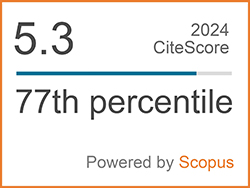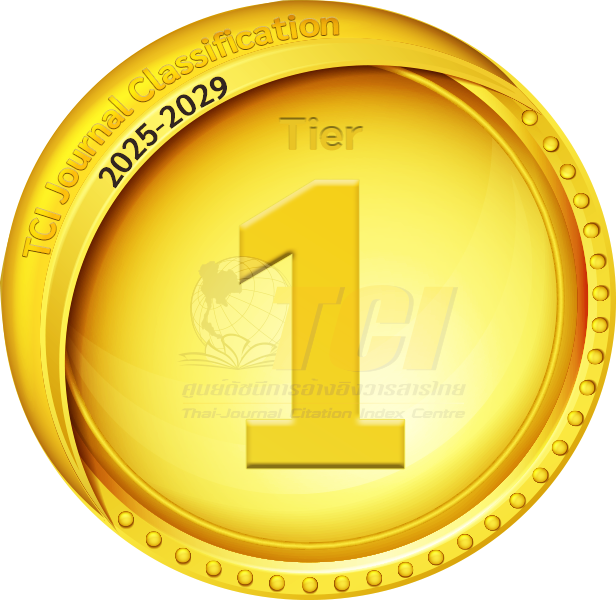Biosynthesis of Silver Nanoparticles using Myrmecodia sp. Bulb Extract: in vivo Wound Healing Potency in Mus musculus L.
Abstract
Keywords
[1] A. Meher, A. Tandi, S. Moharana, S. Chakroborty, S. S. Mohapatra, A. Mondal, S. Dey, and P. Chandra, “Silver nanoparticle for biomedical applications: A review,” Hybrid Advances, vol. 6, 2024, Art. no. 100184, doi: j.hybadv.2024.100184.
[2] A. Puri, P. Mohite, S. Maitra, V. Subramaniyan, V. Kumarasamy, D. E. Uti, A. A. Sayed, F. M. El-Demerdash, M. Algahtani, and A. F. El-Kott, “From nature to nanotechnology: The interplay of traditional medicine, green chemistry, and biogenic metallic phytonanoparticles in modern healthcare innovation and sustainability,” Biomedicine and Pharmacotherapy, vol. 170, 2024, Art. no. 116083, doi: 10.1016/j.biopha. 2023.116083.
[3] M. Qubtia, S. A. Ghumman, S. Noreen, H. Hameed, S. Noureen, R. Kausar, A. Irfan, P. Akhtar Shah, H. Afzal, and M. Hameed, “Evaluation of plant-based silver nanoparticles for antioxidant activity and promising wound-healing applications,” ACS Omega, vol. 9, no. 10, pp. 12146–12157, 2024.
[4] J. Horne, C. D. Bleye, P. Lebrun, K. Kemik, T. V. Laethem, P.-Y. Sacré, P. Hubert, C. Hubert, and E. Ziemons, “Optimization of silver nanoparticles synthesis by chemical reduction to enhance sers quantitative performances: Early characterization using the quality by design approach,” Journal of Pharmaceutical and Biomedical Analysis, vol. 233, 2023, Art. no. 115475, doi: 10.1016/j.jpba.2023.115475.
[5] P. K. Dikshit, J. Kumar, A. K. Das, S. Sadhu, S. Sharma, S. Singh, P. K. Gupta, and B. S. Kim, “Green synthesis of metallic nanoparticles: Applications and limitations,” Catalysts, vol. 11, no. 8, p. 902, 2021.
[6] K. N. Thakkar, S. S. Mhatre, and R. Y. Parikh, “Biological synthesis of metallic nanoparticles,” Nanomedicine: Nanotechnology, Biology and Medicine, vol. 6, no. 2, pp. 257–262, 2010.
[7] N. M. Ishak, S. Kamarudin, and S. Timmiati, “Green synthesis of metal and metal oxide nanoparticles via plant extracts: An overview,” Materials Research Express, vol. 6, no. 11, pp. 1–14, 2019.
[8] F. Trotta, A. Dony, M. Mok, A. Grillo, T. Whitehead‐Clarke, S. Homer‐Vanniasinkam, and A. Kureshi, “In vitro characterization of bionanocomposites with green silver nanoparticles: A step towards sustainable wound healing materials,” Nano Select, vol. 5, no. 2, pp. 1–14, 2023.
[9] H. Achmad, S. Horax, S. Ramadhany, H. Handayani, R. Pratiwi, S. Oktawati, N. Faizah, and M. Sari, “Resistivity of ant nest (myrmecodia pendans) on ethanol fraction burkitt's lymphoma cancer cells (invitro) through interleukin 8 angiogenesis obstacles (il-8),” Journal of International Dental and Medical Research, vol. 12, no. 2, 2019.
[10] J. Sudiono, C. T. Oka, and P. Trisfilha, “The scientific base of myrmecodia pendans as herbal remedies,” British Journal of Medicine and Medical Research, vol. 8, no. 3, pp. 230–237, 2015.
[11] R. A. Nugroho, R. Aryani, H. Manurung, Y. P. Sari, and R. Rudianto, “Myrmecodia pendens bulb extract in the lele dumbo (clarias gariepinus) feed: Effects on the growth performance, survival, and blood indices,” Journal of Aquaculture and Fish Health, vol. 11, no. 1, pp. 21–36, 2022.
[12] N. P. Hanh, N. H. T. Phan, N. T. D. Thuan, T. T. H. Hanh, L. T. Vien, N. P. Thao, N. V. Thanh, N. X. Cuong, N. Q. Binh, N. H. Nam, P. V. Kiem, Y. H. Kim, and C. V. Minh “Two new simple iridoids from the ant-plant Myrmecodia tuberosa and their antimicrobial effects,” Natural Product Research, vol. 30, no.18, pp. 2071–2076, 2016, doi: 10.1080/14786419.2015. 1113412.
[13] A. Oliveira, S. Simões, A. Ascenso, and C. P. Reis, “Therapeutic advances in wound healing,” Journal of Dermatological Treatment, vol. 33, no. 1, pp. 2–22, 2022, doi: 10.1080/09546634. 2020.1730296.
[14] S. L. Percival, D. Williams, T. Cooper, and J. Randle, Biofilms in Infection Prevention and Control: A Healthcare Handbook. New York: Academic Press, pp. 127–139, 2014.
[15] J. D. Jones, H. E. Ramser, A. E. Woessner, and K. P. Quinn, “In vivo multiphoton microscopy detects longitudinal metabolic changes associated with delayed skin wound healing,” Communications Biology, vol. 1, 2018, Art. no. 198, doi: 10.1038/s42003-018-0206-4.
[16] Y. Dutt, R. P. Pandey, M. Dutt, A. Gupta, A. Vibhuti, V. S. Raj, C.-M. Chang, and A. Priyadarshini, “Silver nanoparticles phytofabricated through Azadirachta indica: Anticancer, apoptotic, and wound-healing properties,” Antibiotics, vol. 12, no. 1, 2023, doi: 10.3390/antibiotics12010121.
[17] N. Assad, M. Naeem-ul-Hassan, M. A. Hussain, A. Abbas, M. Sher, G. Muhammad, Y. Assad, and M. Farid-ul-Haq, “Diffused sunlight assisted green synthesis of silver nanoparticles using Cotoneaster nummularia polar extract for antimicrobial and wound healing applications,” Natural Product Research, pp. 1–15, 2023, doi: 10.1080/14786419.2023.2295936.
[18] A. H. Al-Nadaf, A. Awadallah, and S. Thiab, “Superior rat wound-healing activity of green synthesized silver nanoparticles from acetonitrile extract of Juglans regia L: Pellicle and leaves,” Heliyon, vol. 10, no. 2, 2024, doi: 10.1016/ j.heliyon.2024.e24473.
[19] R. Z. Maarebia, A. W. Wahab, and P. Taba, “Synthesis and characterization of silver nanoparticles using water extract of sarang semut (Myrmecodia pendans) for blood glucose sensors,” Jurnal Akta Kimia Indonesia (Indonesia Chimica Acta), vol. 12, no. 1, pp. 29–46, 2019, doi: 10.20956/ica.v12i1.5881.
[20] V. Kalynovskyi, O. Smirnov, P. Zelena, Y. Yumyna, M. Kovalenko, V. Dzhagan, M. Dzerzhynsky, and N. Taran, “Biosynthesis of silver nanoparticles with antioxidant and bactericidal activities using Capsicum annuum fruit extract,” Regulatory Mechanisms in Biosystems, vol. 14, no. 3, pp. 393–398, 2023, doi: 10.15421/ 022358.
[21] H. Barabadi, F. Mojab, H. Vahidi, B. Marashi, N. Talank, O. Hosseini, and M. Saravanan, “Green synthesis, characterization, antibacterial and biofilm inhibitory activity of silver nanoparticles compared to commercial silver nanoparticles,” Inorganic Chemistry Communications, vol. 129, 2021, Art. no. 108647, doi: 10.1016/j.inoche. 2021.108647.
[22] R. Aryani, R. A. Nugroho, H. Manurung, R. Mardayanti, R. Rudianto, W. Prahastika, A. Auliana, and A. P. B. Karo, “Ficus deltoidea leaves methanol extract promote wound healing activity in mice,” EurAsian Journal of Biosciences, vol. 14, pp. 85–91, 2020.
[23] B. Tekleyes, S. A. Huluka, K. Wondu, and Y. T. Wondmkun, “Wound healing activity of 80% methanol leaf extract of Zehneria scabra (L.f) Sond (cucurbitaceae) in mice,” Journal of experimental pharmacology, vol. 13, pp. 537–544, 2021, doi: 10.2147/JEP.S303808.
[24] J. H. Waterborg, “The lowry method for protein quantitation,” in the Protein Protocols Handbook, Berlin, Germany: Springer Nature, pp. 7–10, 2009.
[25] R. A. Nugroho, R. Aryani, H. Manurung, R. Rudianto and D. Prameswari, “Wound healing potency of Terminalia catappa in mice (Mus musculus),” EurAsian Journal of BioSciences, vol. 13, no. 2, pp. 2337–2342, 2019.
[26] M. Karimi, P. Parsaei, S. Y. Asadi, S. Ezzati, R. K. Boroujeni, A. Zamiri, and M. Rafieian-Kopaei, “Effects of Camellia sinensis ethanolic extract on histometric and histopathological healing process of burn wound in rat,” Middle East Journal of Scientific Research, vol. 13, no. 1, pp. 14–19, 2013.
[27] T. R. Anju, S. Parvathy, M. V. Veettil, J. Rosemary, T. H. Ansalna, M. M. Shahzabanu, and S. Devika, “Green synthesis of silver nanoparticles from Aloe vera leaf extract and its antimicrobial activity,” Materials Today: Proceedings, vol. 43, pp. 3956–3960, 2021, doi: 10.1016/j.matpr.2021.02.665.
[28] F. Mohammadi, M. Yousefi, and R. Ghahremanzadeh, “Green synthesis, characterization and antimicrobial activity of silver nanoparticles (AgNPs) using leaves and stems extract of some plants,” Advanced Journal of Chemistry-Section A, vol. 2 no. 4, pp. 266–275, 2019, doi: 10.33945/SAMI/AJCA.2019.4.1.
[29] A. John, A. Shaji, K. Velayudhannair, M. Nidhin, and G. Krishnamoorthy, “Anti-bacterial and biocompatibility properties of green synthesized silver nanoparticles using Parkia biglandulosa (Fabales: Fabaceae) leaf extract,” Current Research in Green and Sustainable Chemistry, vol. 4, 2021, Art. no. 100112, doi: 10.1016/j.crgsc.2021.100112.
[30] A. R. Vilchis-Nestor, V. Sánchez-Mendieta, M. A. Camacho-López, R. M. Gómez-Espinosa, M. A. Camacho-López, and J. A. Arenas-Alatorre, “Solventless synthesis and optical properties of au and ag nanoparticles using Camellia sinensis extract,” Materials letters, vol. 62, no. 17–18, pp. 3103–3105, 2008, doi: 10.1016/j.matlet.2008. 01.138.
[31] S. Kumar, S. Taneja, S. Banyal, M. Singhal, V. Kumar, S. Sahare, S.-L. Lee, and R. K. Choubey, “Bio-synthesised silver nanoparticle-conjugated l-cysteine ceiled mn: Zns quantum dots for eco-friendly biosensor and antimicrobial applications,” Journal of Electronic Materials, vol. 50, pp. 3986–3995, 2021, doi: 10.1007/ s11664-021-08926-4.
[32] M. M. Martin and R. E. Sumayao Jr, “Facile green synthesis of silver nanoparticles using Rubus rosifolius linn aqueous fruit extracts and its characterization,” Applied Science and Engineering Progress, vol. 15, no. 3, 2022, doi: 10.14416/j.asep.2021.10.011.
[33] E. Wu, Y. Li, Q. Huang, Z. Yang, A. Wei, and Q. Hu, “Laccase immobilization on amino-functionalized magnetic metal organic framework for phenolic compound removal,” Chemosphere, vol. 233, pp. 327–335, 2019, doi: 10.1016/j.chemosphere.2019.05.150.
[34] A. N. Chaudhari and A. G. Ingale, “Syzygium aromaticum extract mediated, rapid and facile biogenic synthesis of shape-controlled (3D) silver nanocubes,” Bioprocess and Biosystems Engineering, vol. 39, pp. 883–891, 2016. doi: 10.1007/s00449-016-1567-z.
[35] M. Sharifi-Rad, H. S. Elshafie, and P. Pohl, “Green synthesis of silver nanoparticles (agnps) by Lallemantia royleana leaf extract: Their bio-pharmaceutical and catalytic properties,” Journal of Photochemistry and Photobiology A: Chemistry, vol. 448, 2024, Art. no. 115318, doi: 10.1016/j.jphotochem.2023.115318.
[36] M. A. Alqahtani, M. R. Al Othman, and A. E. Mohammed, “Bio fabrication of silver nanoparticles with antibacterial and cytotoxic abilities using lichens,” Scientific Reports, vol. 10, no. 1, 2020, doi: 10.1038/s41598-020-73683-z.
[37] S. Fatimah, R. Ragadhita, D. F. Al Husaeni, and A. B. D. Nandiyanto, “How to calculate crystallite size from x-ray diffraction (XRD) using scherrer method,” ASEAN Journal of Science and Engineering, vol. 2, no. 1, pp. 65–76, 2022, doi: 10.17509/ajse.v2i1.37647.
[38] B. Yadav, R. K. Yadav, G. Srivastav, and R. Yadav, “Experimental raman, ftir and uv-vis spectra, DFT studies of molecular structures and conformations, barrier heights against internal rotations, thermodynamic functions and bioactivity of biologically active compound-isorhamnetin,” Polycyclic Aromatic Compounds, vol. 44, no. 3, pp. 1609–1643, 2024, doi: 10.1080/10406638.2023.2201460.
[39] H. Peng, H. Guo, P. Gao, Y. Zhou, B. Pan, and B. Xing, “Reduction of silver ions to silver nanoparticles by biomass and biochar: Mechanisms and critical factors,” Science of The Total Environment, vol. 779, 2021, Art. no. 146326, doi: 10.1016/j.scitotenv.2021.146326.
[40] I. Uddin, K. Ahmad, A. A. Khan, and M. A. Kazmi, “Synthesis of silver nanoparticles using Matricaria recutita (babunah) plant extract and its study as mercury ions sensor,” Sensing and Bio-Sensing Research, vol. 16, pp. 62–67, 2017, doi: 10.1016/j.sbsr.2017.11.005.
[41] S. L. Ramírez-Rosas, E. Delgado-Alvarado, L. O. Sanchez-Vargas, A. L. Herrera-May, M. G. Peña-Juarez, and J. A. Gonzalez-Calderon, “Green route to produce silver nanoparticles using the bioactive flavonoid quercetin as a reducing agent and food anti-caking agents as stabilizers,” Nanomaterials, vol. 12, no. 19, 2022, doi: 10.3390/nano12193545.
[42] T. Maheswary, A. A. Nurul, and M. B. Fauzi, “The insights of microbes’ roles in wound healing: A comprehensive review,” Pharmaceutics, vol. 13, no. 7, 2021, doi: 10.3390/pharmaceutics13070981.
[43] M. Kumar, U. K. Mandal, and S. Mahmood, Dermatological Formulations, in Dosage Forms, Formulation Developments and Regulations. New York: Academic Press, pp. 613–642, 2024.
[44] K. Maliyar, A. Mufti, and R. G. Sibbald, “The use of antiseptic and antibacterial agents on wounds and the skin,” in Local Wound Care for Dermatologists, Berlin: Germany: Springer Nature, pp. 35–52, 2020, doi: 10.1007/978-3-030-28872-3_5.
[45] N. Abbasi, H. Ghaneialvar, R. Moradi, M. M. Zangeneh, and A. Zangeneh, “Formulation and characterization of a novel cutaneous wound healing ointment by silver nanoparticles containing Citrus lemon leaf: A chemobiological study,” Arabian Journal of Chemistry, vol. 14, no. 7, 2021, Art. no. 103246, doi: 10.1016/j.arabjc.2021.103246.
[46] A. Salleh, R. Naomi, N. D. Utami, A. W. Mohammad, E. Mahmoudi, N. Mustafa, and M. B. Fauzi, “The potential of silver nanoparticles for antiviral and antibacterial applications: A mechanism of action,” Nanomaterials, vol. 10, no. 8, 2020, doi: 10.3390/nano10081566.
[47] B. Reidy, A. Haase, A. Luch, K. A. Dawson, and I. Lynch, “Mechanisms of silver nanoparticle release, transformation and toxicity: A critical review of current knowledge and recommendations for future studies and applications,” Materials, vol. 6, no. 6, pp. 2295–2350, 2013, doi: 10.3390/ma6062295.
[48] E. A. Hayouni, K. Miled, S. Boubaker, Z. Bellasfar, M. Abedrabba, H. Iwaski, H. Oku, T. Matsui, F. Limam, and M. Hamdi, “Hydroalcoholic extract based-ointment from Punica granatum L. peels with enhanced in vivo healing potential on dermal wounds,” Phytomedicine, vol. 18, no. 11, pp. 976–984, 2011, doi: 10.1016/ j.phymed.2011.02.011.
[49] R. Putrianirma, N. Triakoso, M. N. Yunita, I. S. Yudaniayanti, I. S. Hamid, and F. Fikri, “Efektivitas ekstrak daun afrika (Vernonia amygdalina) secara topikal untuk reepitelisasi penyembuhan luka insisi pada tikus putih (Rattus novergicus),” Jurnal Medika Veterinaria, vol. 2, no. 1, pp. 30–35, 2019, doi: 10.20473/jmv.vol2. iss1.2019.30-35.
[50] I. M. Comino-Sanz, M. D. López-Franco, B. Castro, and P. L. Pancorbo-Hidalgo, “The role of antioxidants on wound healing: A review of the current evidence,” Journal of Clinical Medicine, vol. 10, no. 16, 2021, doi: 10.3390/jcm10163558.
[51] M. Daulay, M. Syahputra, M. I. Sari, T. Widyawati, and D. R. Anggraini, “The potential of Myrmecodia pendans in preventing complications of diabetes mellitus as an antidiabetic and antihyperlipidemic agent,” Open Veterinary Journal, vol. 14, no. 7, pp. 1607–1613, 2024, doi: 10.5455/OVJ.2024.v14.i7.10.
[52] J. H. Faleiro, R. C. Gonçalves, M. N. G. dos Santos, D. P. da Silva, P. L. F. Naves, and G. Malafaia, “The chemical featuring, toxicity, and antimicrobial activity of psidium cattleianum (myrtaceae) leaves,” New Journal of Science, vol. 2016, no. 1, 2016, doi: 10.1155/2016/ 7538613.
[53] S. Bhattacharjee, C. Ghosh, A. Sen, and M. Lala, “Characterization of Firmiana colorata (roxb.) r. Br. Leaf extract and its silver nanoparticles reveal their antioxidative, anti-microbial, and anti-inflammatory properties,” International Nano Letters, vol. 13, pp. 235–247, 2023, doi: 10.1007/s40089-023-00392-6.
[54] P. A Manar, S. E. P. Utama, G. M. Hasan, and M. S. Hidayat. “The potential of sarang semut (Myrmecodia spp) as medicinal plants,” IOP Conference Series: Earth and Environmental Science, vol. 394, 2019, Art. no. 012032, doi: 10.1088/1755-1315/394/1/012032.
[55] C. Theoret and J. Schumacher, Equine Wound Management. New York: John Wiley and Sons, 2016.
[56] I. A. Darby, B. Laverdet, F. Bonté, and A. Desmoulière, “Fibroblasts and myofibroblasts in wound healing,” Clinical, Cosmetic and Investigational Dermatology, vol. 7, pp. 301–311, 2014, doi: 10.2147/CCID.S50046.
[57] A. Stunova and L. Vistejnova, “Dermal fibroblasts—a heterogeneous population with regulatory function in wound healing,” Cytokine and Growth Factor Reviews, vol. 39, pp. 137–150, 2018, doi: 10.1016/j.cytogfr.2018.01.003.
[58] M. P. Fara, S. Kakoolaki, A. Asghari, I. Sharifpour, and R. Kazempoor, “Review Article: Wound healing by functional compounds of Echinodermata, Spirulina and chitin products,” Sustainable Aquaculture and Health Management Journal, vol. 6 no. 2, pp. 23–38, 2020, doi: 10.52547/ijaah.6.2.23
[59] L. R. L. Diniz, L. L. Calado, A. B. S. Duarte, and D. P. de Sousa, “Centella asiatica and its metabolite asiatic acid: Wound healing effects and therapeutic potential,” Metabolites, vol. 13, no. 2, 2023, doi: 10.3390/metabo13020276.
[60] V. A. S David, V. R. Güiza-Argüello, M. L. Arango-Rodríguez, C. L. Sossa, and S. M. Becerra-Bayona, “Decellularized tissues for wound healing: Towards closing the gap between scaffold design and effective extracellular matrix remodeling,” Frontiers in Bioengineering and Biotechnology, vol. 10, 2022, doi: 10.3389/fbioe.2022.821852.
DOI: 10.14416/j.asep.2025.06.003
Refbacks
- There are currently no refbacks.
 Applied Science and Engineering Progress
Applied Science and Engineering Progress







